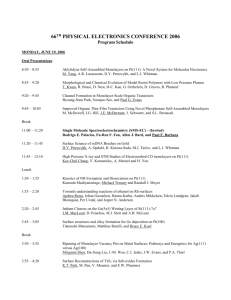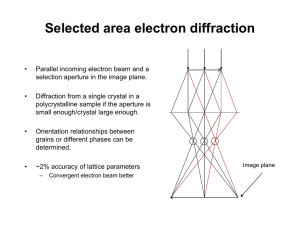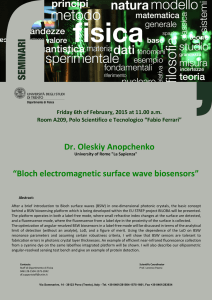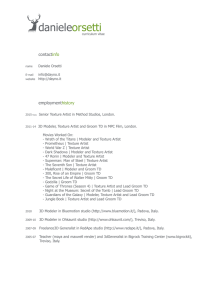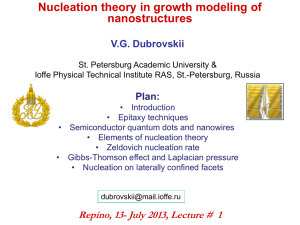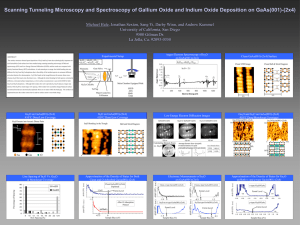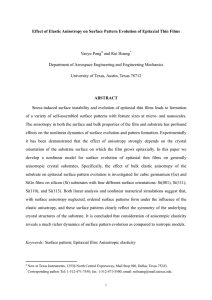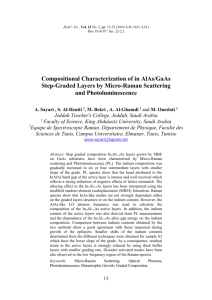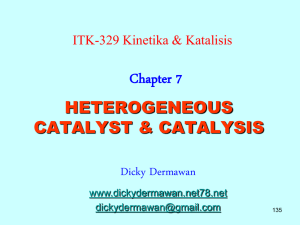ppt
advertisement
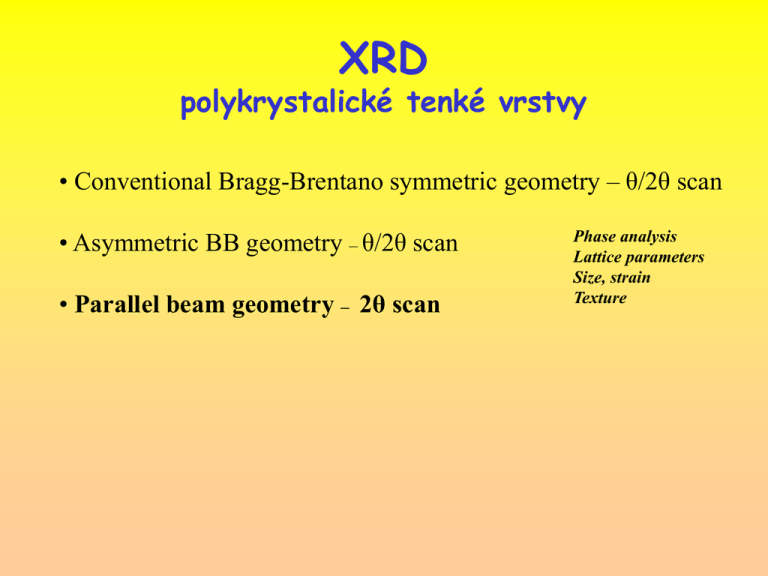
XRD polykrystalické tenké vrstvy • Conventional Bragg-Brentano symmetric geometry – θ/2θ scan • Asymmetric BB geometry – θ/2θ scan • Parallel beam geometry – 2θ scan Phase analysis Lattice parameters Size, strain Texture Bragg-Brentano conventional powder diffraction geometry Symmetric - 2 scan 3 h3k3l3 2 h2k2l2 1 h1k1l1 Information from the grains oriented with the corresponding planes parallel to the surface Absorpce a b b Lineární absorpční koeficient Energie z hloubky t za 1 s dI I 0 A 2 ab sin 2 sin 2 sin cos sin 2 sin 2 2 sin cos cos 2 1 cos 2 Ae Gt sin sin b G sin sin b Asymmetric powder diffraction geometry 3 h k l 3 3 3 h2k2l2 2 2 scan 1 h1k1l1 Small constant angle of incidence g Parallel beam g = 2 – 10 Picture from Seifert poster XRD Seifert - FPM Monochromator Detector Parallel plate collimator Slits X-ray tube Sample holder C. Bragg-Brentano asymmetric powder diffraction geometry 3 h3k3l3 hkl 2 2 2 2 1 h1k1l1 - 2 scan goniometer Ygoniometer Texture Stress Philips X’Pert MRD Eulerian cradle Sample stage X-ray tube Parallel plate collimator Detector Goebel mirror Polycapillary Texture and Stress Omega sken PbTiO3 s can 500 I(cps) 400 300 FWHM 200 100 0 5 Korekce na absorpci a defokusaci 10 15 20 25 30 - sken Texture, stress Pole figures 515 nm 935 nm 2000 nm Pole figure (100) for the samples of different thickness. The asymmetry of the texture (left, middle) as well as the inclination of the texture (right) can be seen in 2.5D plot. 2D reciprocal space scan 2scan 2 2 scan scan Ideal single crystal Ideal polycrystal Textured polycrystal 0 Zbytková napětí Homogenní napětí 1. druhu (s). d 1 hkl s2 s sin 2 2 s1hkls d 2 Může být určováno přímo známou metodou sin2, kdy musí být vzorek nakláněn na různé úhly ze symetrické polohy tak, aby difraktovaly atomové roviny různě skloněné vůči povrchu. Uvedený výraz platí přesně pouze pro jednoosá napětí (0 pro symetrickoul Braggovu-Brentanovu geometrii). Rtg elastické konstanty n 1 n s1 , s2 E E n… Poissonovo číslo, E … Youngův modul Elasticky izotropní materiály tlakové napětí Elastická anizotropie + Reussův model ( skonst. maximální závislost na hkl ) a s1R ,hkl s12 s0 , 1 R ,hkl s2 s11 s12 3s0 2 h 2 k 2 h 2l 2 k 2l 2 , s0 s11 s12 0.5s44 (h 2 k 2 l 2 ) 2 222 400 311 311 111 200 a0 Hodnota bez napětí cos cot Back 2 sken 422 422 goniometr goniometr Crystallite Group Method BB - 0 BB - 0 For thin films and some bulk materials the orientation of grains with respect to the surface may be very important. Differently oriented grains can have very different defect content and/or be in very different stress state. Therefore it is desirable to measure various crystallite families (texture components) rather than individual planes. Of course, as it is not the case of single crystals, other crystallites always contribute to the profile (less for strong texture). Hloubka průniku t Nekonečná tloušťka I dI dt t t 0 Hloubka průniku Efektivní hloubka průniku 1 1 t ln r Poměr energií difraktovaných tenkou vrstvou na povrchu a tenkou vrstvou v hloubce t 1 1 ln ; dI ( z ) / dI ( z 0) r G r r e r e Informační hloubka 1 te Gt i z dz / Adz G 1 e Gt 0 0 Přispívající tloušťka I (z R ) R I (z t) Ekvivalentní tloušťka 1 e Gt eq G G t t R 1 1 ln G (1 R) Re Gt - 2 (BB) Hloubka průniku 2 (SB, PB) Rutile P42/mnm 4.5977 4.5977 2.9564 b: 5.44900 a: 3.77100 Anatase I41/amd 3.7710 3.7710 9.430 Brookite Pbca 9.174 5.449 5.138 4 00 P o wde r S im u la ti o n 3 50 Rutile 3 00 2 50 2 00 1 50 1 00 50 0 2 0. 0 2 5. 0 3 0. 0 3 5. 0 2 4 0. 0 4 5. 0 5 0. 0 3 50 P o wde r S im u la ti o n Anatase 3 00 2 50 2 00 1 50 1 00 50 0 2 0. 0 2 5. 0 3 0. 0 3 5. 0 2 4 0. 0 4 5. 0 5 0. 0 1 80 P o wde r S im u la ti o n Brookite 1 60 1 40 1 20 1 00 80 60 40 20 0 2 0. 0 2 5. 0 3 0. 0 3 5. 0 2 4 0. 0 4 5. 0 5 0. 0 Parallel beam geometry Bragg-Brentano symmetric geometry Thickness - 0.6 m 3 deg, 100 C 3 deg, 300 C BB, 300 C I(cps) 600 Anatase 400 Amorphous 200 0 10 30 50 2 70 Williamson-Hall plot 0.008 Williamson-Hall plot Integral breadth (1/d) 0.007 0.006 0.005 0.004 h = 800 nm ann. 300 oC Crystallite size > 100 nm Microstrain ~ 0.15 % 0.003 ~ microstrain 0.002 0.001 ~ 1/crystallite size sin 0 0 0. 1 0.2 0.3 0.4 0.5 0. 6 0.7 0. 8 0.9 1 measurements from both XRD7 and X’Pert diffractometers 2and-2 scans b hkl (1 / d ) 1 4ehkl sin Dhkl Apparent crystallite size Lattice strain e=d/d Texture indices Thicker Thinner 2.0/250 2.0/300 1.7/300 1.5/300 1.2/300 101 1.2 1 1.2 1.6 1.7 004 3 2.1 1.3 1.1 1.1 112 0.5 0.5 0.8 1Fiber texture 0.9 200 1.2 0.9 0.7 1 1.1 105 1.6 1.2 1.1. 0.9 1 211 0.6 0.5 0.6 0.9 0.9 Residual stress Stress: 383,5 ± 19,9 MPa Phi = 0,0° 1.2654 1.2652 1.2650 • 1.2648 d-spacing (A) 1.2646 1.2644 1.2642 1.2640 • • • • isotropic elastic constants (E = 190 GPa, ν = 0,31) tensile stress at 500 C drop of stress stresses ~ 200 - 300 MPa typical stress anisotropy 1.2638 1,54 m at 300 C for (215) 1.2636 1.2634 1.2632 0.0 0.1 0.2 0.3 0.4 0.5 0.6 0.7 0.8 0.9 sin ² (Psi) Typical linear dependence Isotropic stress, absence of tri-axial stresses Stress d(105) [A] 1.701 Thick ness [nm] 1.5m, 300°C 1.5m, 350°C 1.700 s [MPa] 300 C 200 1.699 350 C 500 C 341 151 630 187 187 42 800 219 209 - 1000 184 154 - 1500 240 163 - 1700 280 232 - 2000 293 252 - 1.698 0.0 0.2 0.4 0.6 sin 2 0.8 Stress anisotropy 0.2 m, 300°C 0.8 m, 300°C 0.8 m, 350°C 1.5 m, 300°C 1.5 m, 350°C 0.005 0.004 0.003 0.002 0.001 diffraction peak (215) (220) (116) (211) (105) (200) (112) (004) 0.000 (103) 2 slope of sin plot 0.006 105 Diffraction peaks For different inclinations 211 300 ºC Tensile stress ~ 200 MPa 500 ºC no stress X-ray reflectivity Refraction index n 1 Total reflection n 1 ( ib ), , b ~ 105 2 re e 2 b 4 electron density absorption length re = 2.818 10-15 m - wavelength n 1 r0 N at ( f1 if 2 ) 2 2 c 2 Critical angle Surface roughness, film thickness R R0 exp(16 2s 2 g sin i / 2 ) 10 0 7 10 ~ 1/t t=0,054m 6 10 10 -2 Perfectly smooth surface Reflectivity Reflectivity 10 -1 5 10 Visible up to ~ 300 nm 4 10 3 10 10 10 -3 2 10 1 10 -4 Kiessig maxima 2t sin 2 im sin 2 c m 0 10 10 -5 1 0.3 nm roughness 1 2 angle (deg) 3 2 (degrees) Reflectivity is sensitive only to the projection of the surface profile to its normal direction 2 It cannot distinguish between mechanically and chemically rough surface 3 TiO2 200 nm 250 ºC 350 ºC 450 ºC Increasing roughness with annealing temperature TiO2 200 nm 250 ºC Ω scans TiO2 1 700 nm 350 ºC Ω scan Reflectivity curves Reflectivity t= 1.0 m t= 1.7 m t= 0.054 m t= 1.24 m 6 10 5 10 4 10 Reflektivita as deposited o 350 C o 450 C 6 10 7 10 5 10 4 10 3 10 3 10 2 10 2 10 1 1 10 0 10 10 0 10 -1 10 -1 10 -2 10 -2 0.0 0.5 1.0 1.5 2.0 2.5 3.0 úhel 2 (stupně) Increase of roughness with film thickness 3.5 10 0.0 0.5 1.0 1.5 2.0 2.5 3.0 3.5 4.0 2 Reduction of very thin surface layer with annealing temperature 4 Reflectivity curves fitting Two layer model necessary Surface porous layer 100,000 0,8 m 300 C 10,000 1,000 100 0,054 m 350 C 100,000 10 10,000 0 0 0.1 0.2 0.3 0.4 0.5 0.6 Incident angle (°) Intensity (counts/s) 1 0.7 1,000 0.8 0.9 1 1.1 100 10 Experimental 1 Fitted 0 0 0.1 0.2 0.3 Incident angle (°) 0.4 0.5 Surface roughness Thickness [nm] Fitted thickness [nm] Electron density [g.cm-3] Roughness [nm] 54 57 3.42 1.2 100 93 3.58 1.7 200 200 3.48 1.8 630 569 3.53 4.1 57 3.64 7 968 3.89 2 49 3.68 5 1791 3.89 2 55 3.74 5 2nd layer 1000 2nd layer 1700 2nd layer Depth profiling thickness – 1 m Different angles of incidence () Rutile 110 0.5 0.75 1.0 1.5 2.0 Anatase 101 Rutile growths on the interface while anatase is on the top thickness 935 nm Anatase Angles of incidence in degrees Effective penetration depth 0.5 0.75 1.0 1.5 2.0 100 nm 150 nm 200 nm 300 nm 400 nm Rutile Rutile growths on the interface while anatase is on the top Reflection on multilayers Bragg maxima of multilayer Period d k 2d n 2 cos 2 i d d A dB d k 2(sin 2 sin 1 ) d=T Kiessig maxima Total thickness T Number of ML periods Annealing of amorphous 9x(5 nm Si/ 1 nm W) 4 10 3 10 2 10 1 10 Reflectivity 10x(GaAs 7nm/AlAs 15 nm), CuK1 Kinematical approx: No total reflection region, wrong positions of the satellites (refraction not considered) 0 10 10 -1 10 -2 10 -3 1x10 -4 1x10 -5 10 -6 1 2 3 2 (degrees) 4 Experimental set-up Detector X-ray tube CuK Göbel mirror Slit 0.05 mm Secondary graphite monochromator Slit 0.1mm Sample Diffuse scattering non-specular conditions Thermal fluctuations Correlated layer distortions Height-height correlation function C( X , Y ) z( X , Y ) z(0,0) C( R) s 2 exp(R / )2h Effective cut-off length of the self-affine surface For multilayers C jk ( X , Y ) z j ( X , Y ) z k (0,0) C jk C j Ck exp( | Z j Z k | / ) Vertical interface roughness correlation Fe/Au (70Å/21Å)x13 Low correlation of the interface roughness -1.11 -0.56 0 -0.56 1.11 1.67 6000 3.33 4000 2.22 1.11 2000 -6000 -4000 -2000 0 2000 Sample inclination 4000 6000 Detector angle -1.67 Dynamická difrakce Dynamical diffraction Shift from the kinematical Bragg position (due to refraction) Finite width of the diffraction curve (even for T→0) Asymmetry of the maximum – due to the Borrmann effect Wavefields in crystal Weakly interacts with the atoms – Anomalously low absorption Strongly interacts with the atoms – Anomalously high absorption The Borrmann effect Epitaxní vrstvy strain Tloušťka Implantace Si – B+ D = 3,1.1014 D = 6,2.1015 D = 6,2.1015 a žíhání 1000 ºC bez implantace X-ray grazing incidence diffraction W ~ 1.8 nm na Al2O3 a|| = 0.3184 nm a0 = 0.3165 nm e|| = 0.6 % <D||> 5 nm sken Mozaiková rozorientace ~ 1.1º MBE Mo 22 nm (111) na (001) GaAs Tři domény Mo[110] || GaAs [110] GaAs [1-10] GaAs [100] Mismatch B || -10.2 % ┴ +3.7 % C ┴ +27 % <D> ~ 13 nm Jedna doména Nb[110] || GaAs [100] Nb(001) || GaAs (001) Mismatch 21.1 % Standing waves Standing waves 2 2 | Eh | | Eh | I (r ) | E0 | 1 2 2 cos(h r ) | E0 | | E0 | Amplitude of diffracted wave Phase of (Eh/E0) Amplitude of incoming wave Reciprocal lattice vector Reflection curve – 1 Phase – 2 Intensity at atomic planes – 3 Maximum interaction for = 0, at high angle side of reflection curve Monolayer of adsorbed atoms High sensitivity to displacement of layer ~ 1 % !!! Yield of the fluorescent radiation Adsorbed layers Three adatoms at 0, 1/3, 2/3 Parallel planes Inclined planes Experiment Measurements of secondary radiation under the condition of diffraction Fluorescence Photoelectrons Auger electrons Compton radiation Chemical selectivity Spatial resolution on atomic scale Depth-resolved studies Determination of coherent position – mean plane of the adsorbed atoms and coherent fraction – static and dynamic displacement of atoms from the coherent position Organic materials Long-period standing waves are necessary Bragg diffraction from layered synthetic microstructures with large period 10-200 layer pairs (low and high electron density) Fixed period XSW Total reflection SW is formed as an interference between incident and specularly reflected waves = 0.1 c = c Height dependence of electric field intensity generated during specular reflection of an X-ray plane wave from the mirror surface at three angles of incidence Marker atom A – two E-field maxima marker atom B – five E-field maxima XSW application Monitoring of membrane-related dynamic processes membrane-lipid phase transitions ion movement in membrane Protein folding Membrane-protein insertion Lipid and/or protein distributions Surface binding Distribution of marker atom above the substrate surface Theoretical model Experimental fluorescence, Reflectivity data Layered model of refractive index based on the known structure Adjusting of interfacial roughness Features of XSW Resolution ~ 1 % of LSM d (for 50 Å - 0.3 Å, 925 Å - 3 Å) Element specificity (not suitable for light elements, O, P, S) Structure-determination measurement on isolated lipid membranes (protein monolayers ~ 10 pmol (100 ng) of cytochrome c) Calculation of the angle-dependent electric-field profile and fluorescence-yield profile normal to the surface Adjusting two parameters Membrane-topology measurements on minimally perturbed systems (Fe XSW on Fe-cytochrome c)
